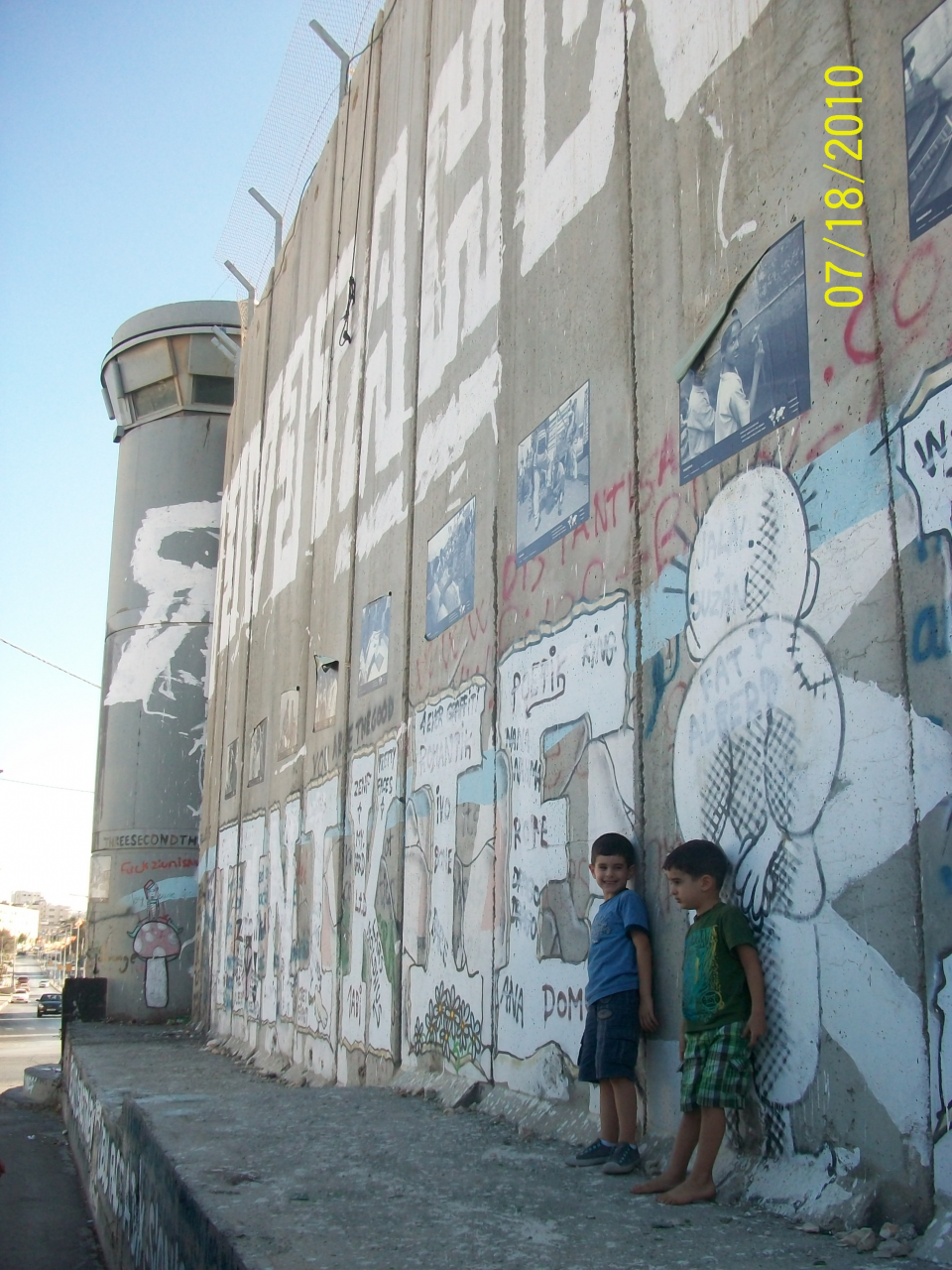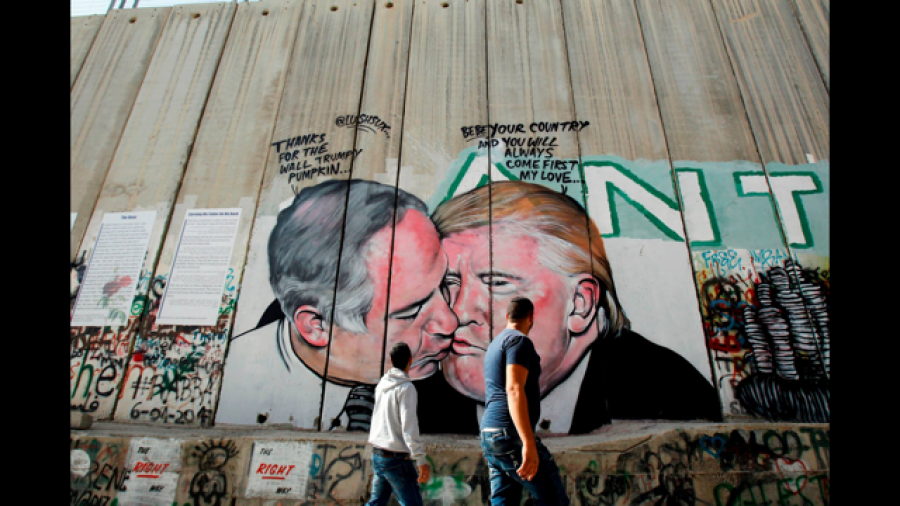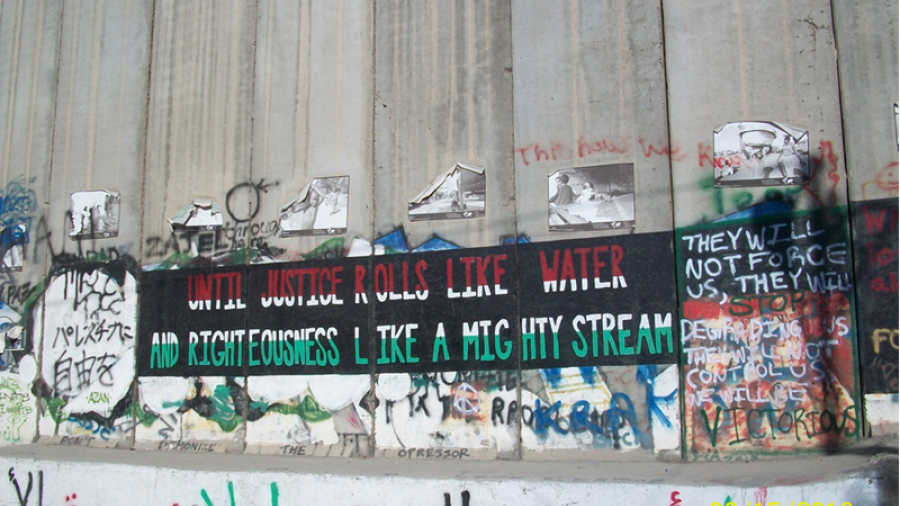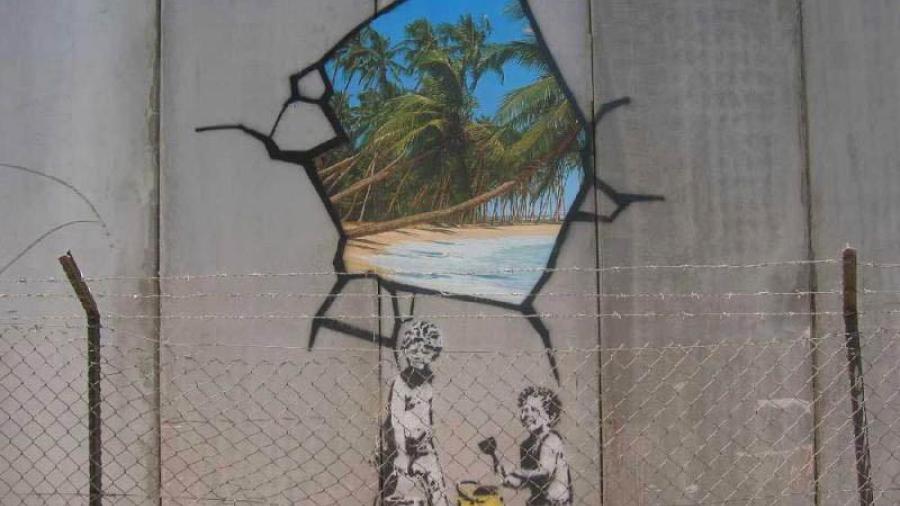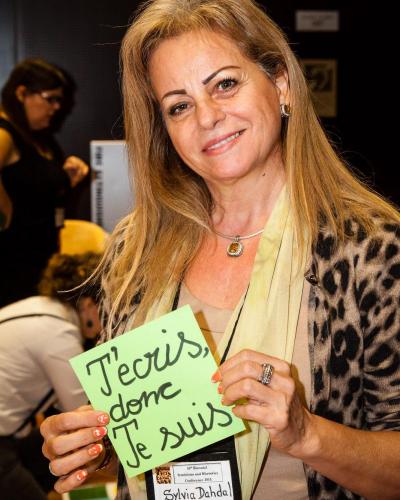The Writing's on the Wall: Art as Non-Violent Protest
We all know that Art is not truth. Art is a lie that makes us realize truth.
–Pablo Picasso
Throughout history, walls have been erected, torn down, celebrated, reviled, and debated. There are infamous walls like the Berlin Wall and the Great Wall of China and the Wailing Wall. In medieval times, walls were built around villages to keep out enemies. Many backyards today are surrounded by brick walls.
English alum Sylvia Dahdal (PhD 2017) studies and writes about a wall that surrounds controversy: it’s the one that separates Israel from the West Bank.
Built during the Second Intifada in the early 2000s—with barbed wire and concrete blocks as high as twenty-six feet—the Israeli West Bank barrier snakes 365 miles along the West Bank of the River Jordan. Known by Israelis as the Separation Wall, it has reduced suicide bombings. However, Palestinians refer to it as the Apartheid Wall because they say it violates their rights to work and land. Many feel segregated and refer to the West Bank as an “open-air prison.” Due to its structure, location, and political atmosphere, this wall has become the largest canvas for graffiti artists from all over the world.
On a trip to the Holy Land several years ago, while passing by a military checkpoint going to Jerusalem from Bethlehem, Dahdal was overwhelmed by the sheer size of the monstrous wall laden with graffiti. “I’d seen graffiti in New York City but not as much crowded on a single surface like the Wall,” she said. “Trying to understand the messages, who writes on the Wall and the stories of the controversial situation was the motive behind studying the rhetoric of this Wall.”
Most of the graffiti is found in Bethlehem, on the part of the Wall around the military checkpoint Qalandiya—the main passage between Jerusalem and Bethlehem. Some days the area is very crowded with tourists, peace activists, and local Palestinians, especially if a graffitist is performing.
Dahdal, whose dissertation was titled The Rhetorics of Political Graffiti on A Divisive Wall, sees the controversial, bold, colorful designs as art that tells stories and creates dialogue producing a wide array of positions not seen on media outlets. She poses that graffiti on the Wall have a universal motive—giving voice to the voiceless and having the ability to prompt sociopolitical change that could lead to a peaceful resolution of the Israeli-Palestinian conflict.
Dahdal’s dissertation discusses the social, physical, psychological and political factors that affect communication between Wall graffitists and their readers, as well as the messages of these graffiti from a Palestinian perspective. Her qualitative study shows that graffiti on this high-profile site are not typical of violent gang graffiti, common in the US, but rather contribute a universal interactive rhetorical message of solidarity and demand for basic human rights for a misrepresented culture.
Dahdal wants people to know that the art on this wall is not like frenzied swirls of graffiti in New York subways or Los Angeles suburbs. The Wall graffiti, displayed on a unique surface in a unique setting, promote cultural and historical understanding and a breakdown of boundaries and stereotypes.
“If these graffiti are not preserved, documented and interpreted from a Palestinian perspective, a great part of the history of the Wall and the people who live in the region will be lost,” she says.
Dahdal argues that the rhetoric of the graffiti on the Wall is not only an evolving type of protest and resistance, but also a non-violent one performed by local and international artists to “protect a misrepresented people, their history and existence, their identity and human rights”.
There are many famous graffiti writers on the Wall, but Dahdal’s favorite is Banksy who performed nine murals on different sections of the Wall in Bethlehem in 2005, and recently opened the “Walled Off Hotel” in Bethlehem to support local Palestinians and to expose the daily struggle of those who live nearby.
We might wonder why a famous artist like Banksy, who is never after propaganda, would risk his life and travel to the Palestinian territories and to Gaza, through secret tunnels from Egypt, to draw his graffiti on demolished homes in a warzone. Dahdal explains that Bansky believes in human rights and in lifting injustices under which Palestinians are suffering. One chapter in Dahdal’s dissertation is devoted to Banksy and his long career focusing on the Palestinian problem while maintaining his secret identity.
Dahdal’s own roots are in Taybeh, the only Christian village in Palestine and mentioned in the Christian Bible as Ephraim, a village that Jesus visited while preaching before his crucifixion. Olive trees in Taybeh date back two thousand years. Dahdal grew up in Amman, Jordan where her parents lived after 1948—when the state of Israel was established and many Palestinians fled. In 1983, her family immigrated to the United States.
Dahdal married at age 21 and lived with her husband in Abu Dhabi where she taught English at the Rosary School: “Once a teacher, I was always a teacher.” After earning her doctorate at ASU in 2017, Dahdal moved back to Abu Dhabi where she now resides with her husband and temporarily works as the director of Apple Bee Nursery while looking for a university position. She is currently editing and transforming her dissertation into a book to be published in June 2018 in the United Arab Emirates (UAE) with a forward by the eminent Youssef Al-Hassan. The dean of New York University Institute of Technology (NYIT) in Abu Dhabi recently invited her to give a lecture about graffiti to the school’s art students. Dahdal is also working on a collection of short stories.
When she’s not writing books or managing Apple Bee’s 16 employees and 50 children, she loves to stroll Al Serkal Avenue in Dubai, an art walk area similar to First Friday in downtown Phoenix. She enjoyed her years at ASU and misses Arizona very much, especially her garden where she planted fresh mint, tomatoes, fig, lemon, and orange trees that reminded her of her parents’ homeland in Palestine—once a land with no dividing wall. The Palestinians of today continue to hope for a future with no walls, no wars.
Perhaps art can build an opening to that peace.
Image 1: For a perspective on the enormous height of the Israeli West Bank barrier, Sylvia Dahdal and her sister-in-law posed at the base of the wall during a 2010 trip to Israel. Note U.S. President Barack Obama's 2008 election campaign motto "Yes We Can" lettered in the colors of the Palestinian flag. Photo courtesy Dahdal.
Image 2: Two boys play near the Israel military watch towers at the Wall. Photo courtesy Dahdal.
Images 3 and 4: In a nod to the Dmitri Vladimirovich Vrubel's "Deadly Kiss" art on the Berlin Wall (first photo: by Freepenguin from Wikimedia) a graffitist has created a "Deadly Kiss" for the Israeli West Bank barrier which features Israeli Prime Minister Benjamin Netanyahu and U.S. President Donald Trump in an embrace. Second photo by Dahdal.
Image 5: A quote from Martin Luther King Jr's famous “I have a dream” speech on the Wall. Note the black background to signify the Civil Rights Movement. Also, the wordings are enwrapped in the colors of the Palestinian flag. Photo by Sylvia Dahdal.
Image 6: Banksy art in 2005 at the Israeli West Bank barrier in Bethlehem. Photo by Markus Ortner from Wikimedia Commons.
Image 7: Dahdal has always been drawn to representations of identity in art and writing. She participated in the National Day on Writing in 2015, which coincided with that year's Feminisms and Rhetorics Conference at ASU, where participants made a "thought quilt" of written squares. For her contribution, Dahdal wrote, in French: "J'écris donc Je suis" ("I write, therefore I am"). Photo by Bruce Matsunaga.


